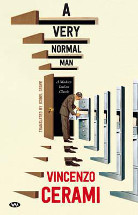A very normal man by Vincenzo Cerami

Translated by Isobel Grave. Wakefield Press, 2015. This is an
English translation of Un Borghese piccolo piccolo, 1976. ISBN
9781743053713
(Age: 17+) Highly recommended. Themes: Revenge; Italian Society;
Purpose; Hope and hopelessness.
A Very Normal Man is a translation of the first novel of
Vincenzo Cerami who is also renowned for his co-authorship of the
screenplay for Life is Beautiful (La vita e bella)
with Roberto Benigni. With the same deft touch, he lightly deals
with a harsh topic as he tiptoes through the tragedy of a normal
life that sinks to extreme measures to grasp at retribution for a
terrible family disaster. At the beginning of this carefully crafted
story we enter the humble circumstances of the central character and
his less than stellar career as a civil servant. His pre-retirement
drudgery is brightened by the prospect of providing more for his son
than was possible in his own life. In order to facilitate this rise
above drudgery and relative working servitude he is enticed to
explore a position within the local Masonic charter and the reader
sees the implicit corruption that follows. On the brink of hope for
his son, tragedy falls and the 'Normal man' sinks into functioning
despondency and a whirlpool of despair that drags him down and
plants the smallest of seeds of revenge into the heart of the simple
man. From this point the black tragedy of the normal life takes on a
secret existence that is almost quirkily humourous, and yet is in
essence, darkly evil. The heart of this story is to reveal the very
easy path that a normal or average man might take in becoming the
worst kind of man. There is irony in the title that this is not a
'normal man'; even though to the world he is a small, insignificant,
'good' man. To the reader who is capable of self-examination, there
is an opportunity to consider their own hidden potential. The
characterisation within this text is subtly revealed, but incredibly
powerful.
The translation of this text has brought this cleverly crafted story
to our attention and this is worthy of study, despite its macabre
aspects, and the journey into Italy in the period post- 1969, with
its potential for corruption at even the most basic level is
intriguing.
Highly recommended for Mature readers aged 17+ (predominantly an
adult novel, but accessible by younger readers.) Note: some macabre
detail included - a 'black' text!
Carolyn Hull